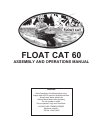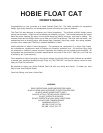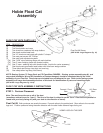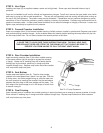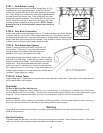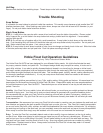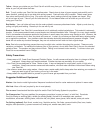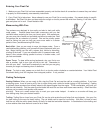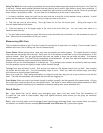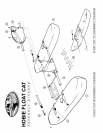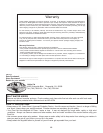
Entering Your Float Cat
1. Make sure your Float Cat has been assembled properly and double check all connections to assure they are locked
in properly for initial assembly, see assembly instructions.
2. Carry Float Cat to lake shore. Never attempt to use your Float Cat on moving waters. It’s present design is specific
to stillwaters. Set Float Cat down on lakes edge far enough on land to prevent the wind from blowing it into lake. Stow
gear and place rod in rack. Check floatation vest.
Maneuvering With Fins
The pontoons are designed to turn easily and also to track well while
under power. Practice these three basic maneuvers until you feel
confident before venturing far from your launch point. With experience,
you can cover lots of water and use subtle variations to make your Float
Cat perform like an extension of yourself. Fins are the primary power
used for fishing but oars can help you cover more water in a shorter
period of time. (see Maneuvering With Oars)
Basic Kick: Now you are ready to move into deeper water. From a
comfortable sitting position, push yourself off shore (backward) with your
feet. Begin kicking your fins with a scissor kick, similar to swimming,
pivoting at the knee. If you are unfamiliar with fin powered water craft,
spend a few minutes kicking parallel to shore, in shallow water, until
you feel comfortable.
Power Turns: To steer while moving backwards, aim your fins to one
side or another; right to turn right and left to turn left. Remember to
aim with your back. Look back occasionally to see that you are going
towards you target and steering clear of obstacles.
Pivots: To pivot on axis, sweep one or both fins in a circular motion clockwise or counterclockwise. Your Hobie Float
Cat should easily pivot 360 degrees from a stopped position. If not, practice!
Fishing Techniques
Casting Platform: When you are ready to fish, stop the Float Cat and use the craft as a casting platform. If you have
a stripping apron, it can be use to put fly line on while fishing and a table for tackle rigging or fish de-hooking. Casting
is generally done anywhere from directly ahead to 90 degree angles from the angler. To fish comfortable, pivot until you
face the cast direction. Find the water type that holds the most fish and then work those areas carefully. Small float tube
anchors can be used to hold position and prevent
wind-drift. Throw out a small marker buoy to mark your open water hotspot. A marker or an anchor will keep you
from drifting away from your desired location.
Trolling: Trolling flies or lures from your Float Cat can be quite productive and helps find new hotspots. Use your fins
for slow trolling or the oars for faster trolling. The rod holder can be used for lure trolling. With flies it is best to hand
hold the rod, with the rod tip aimed directly at the fly for best feel and strike detection. A combination of slow trolling and
a slow retrieve often does well and covers a lot of water.
FINISH KICK AND
DRAW BLADE
STRAIGHT BACK
DROP BACK AND
START KICK
9



